Hampi, a UNESCO World Heritage Site, is a captivating open-air museum brimming with architectural marvels and remnants of the Vijayanagara empire. Nestled amidst these historical wonders lies the Yantrodharaka Hanuman Temple, a place revered for its dedication to Lord Hanuman and its unique portrayal of the monkey god. This guide delves into the temple’s history, architectural significance, and the spiritual experience it offers to visitors.
The Yantrodharaka Hanuman Temple is on a small hill near the Tungabhadra River, close to Chakratirtha. You can find its entrance just behind the Kodandarama Temple, which is about 700 meters away from the Hampi Bus Stand.
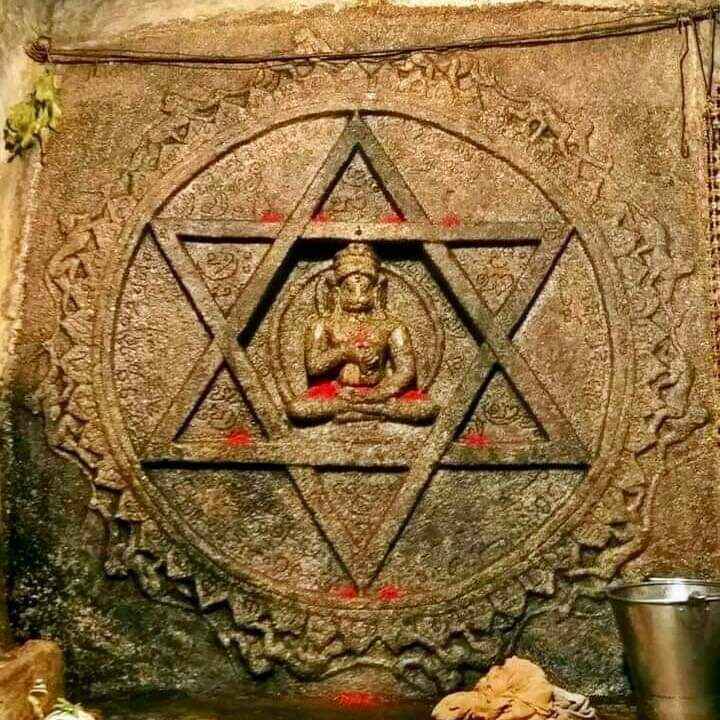
Table of Contents:-
The Yantrodharaka Hanuman temple is open from 7:00 AM to 1:00 PM, closed from 1:00 PM to 3:00 PM, and reopens from 3:00 PM to 6:00 PM. Reaching the temple requires a short climb, offering a chance to soak in the beauty of the surrounding landscape before entering the spiritual haven. The climb itself can be seen as a metaphor for the spiritual journey one undertakes to seek blessings and inner peace.
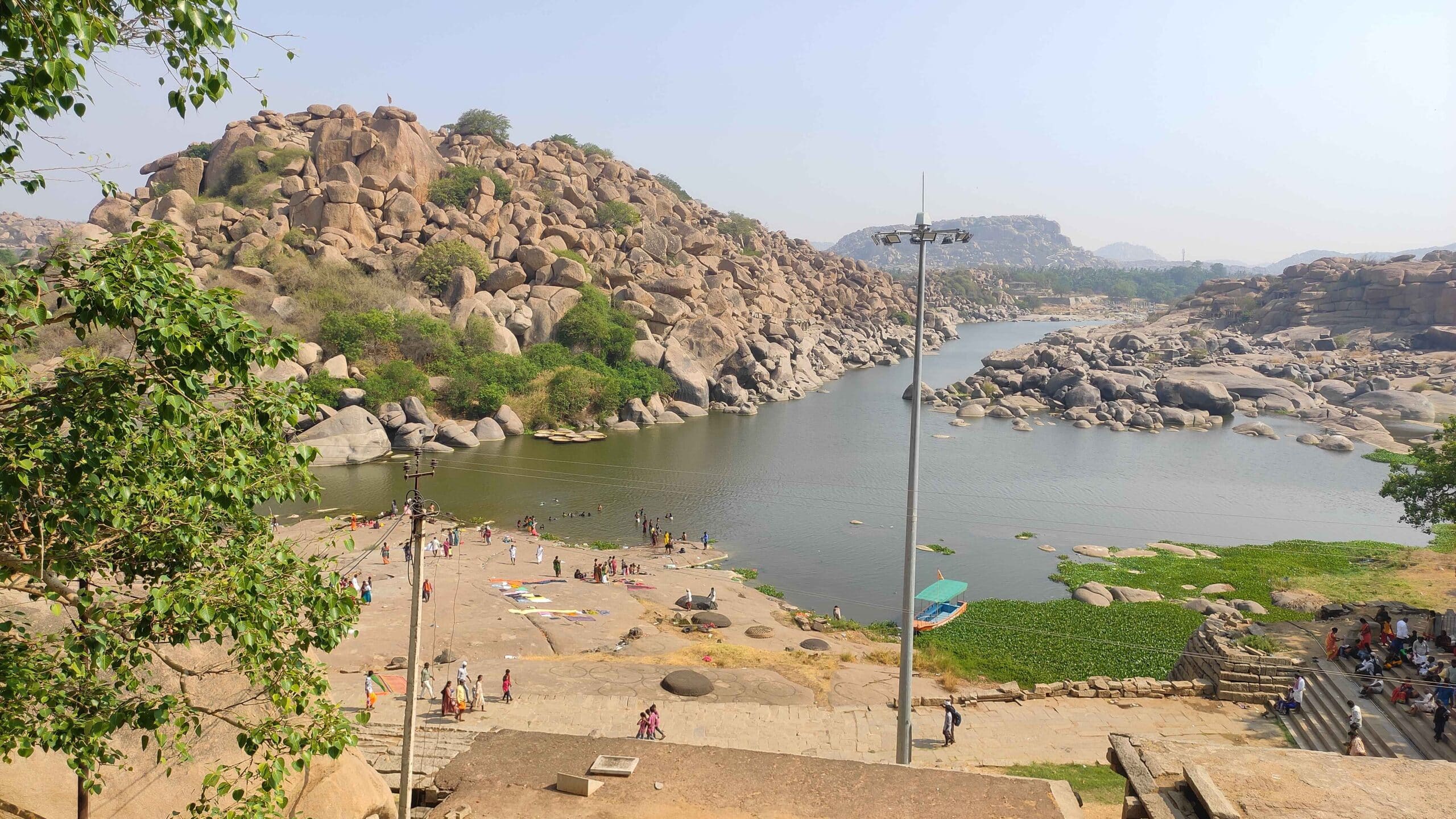
Quick Facts
- Timing: 7:00 AM to 1:00 PM, and 3:00 PM to 6:00 PM
- Entry Fee: No entry fee required
- Photography: Allowed
- Location: Google Maps
- Must-See Attractions
History and Origins
The story behind the Yantrodharaka Hanuman Temple is steeped in devotion and divine visions. Vyasathirtha, the royal preceptor of Krishnadevaraya, had repeated visions of Hanuman while meditating on the banks of the Tungabhadra River. Inspired by these visions, Madwacharya appeared in his dreams and instructed him to install an idol of Anjaneya (Hanuman). The temple was subsequently built during the reign of Krishnadevaraya (1509-1529 CE)[1] and has since been a revered site for devotees seeking blessings.
The temple’s name itself holds deep meaning: “Yantra” translates to instrument or tool, and “dharaka” signifies holder. Here, it refers to the belief that Lord Hanuman holds the Yantra (mystical diagram) within himself, symbolizing his immense power. It is believed that the yantra has the power to ward off evil forces, bring success, and fulfill the wishes of devotees.
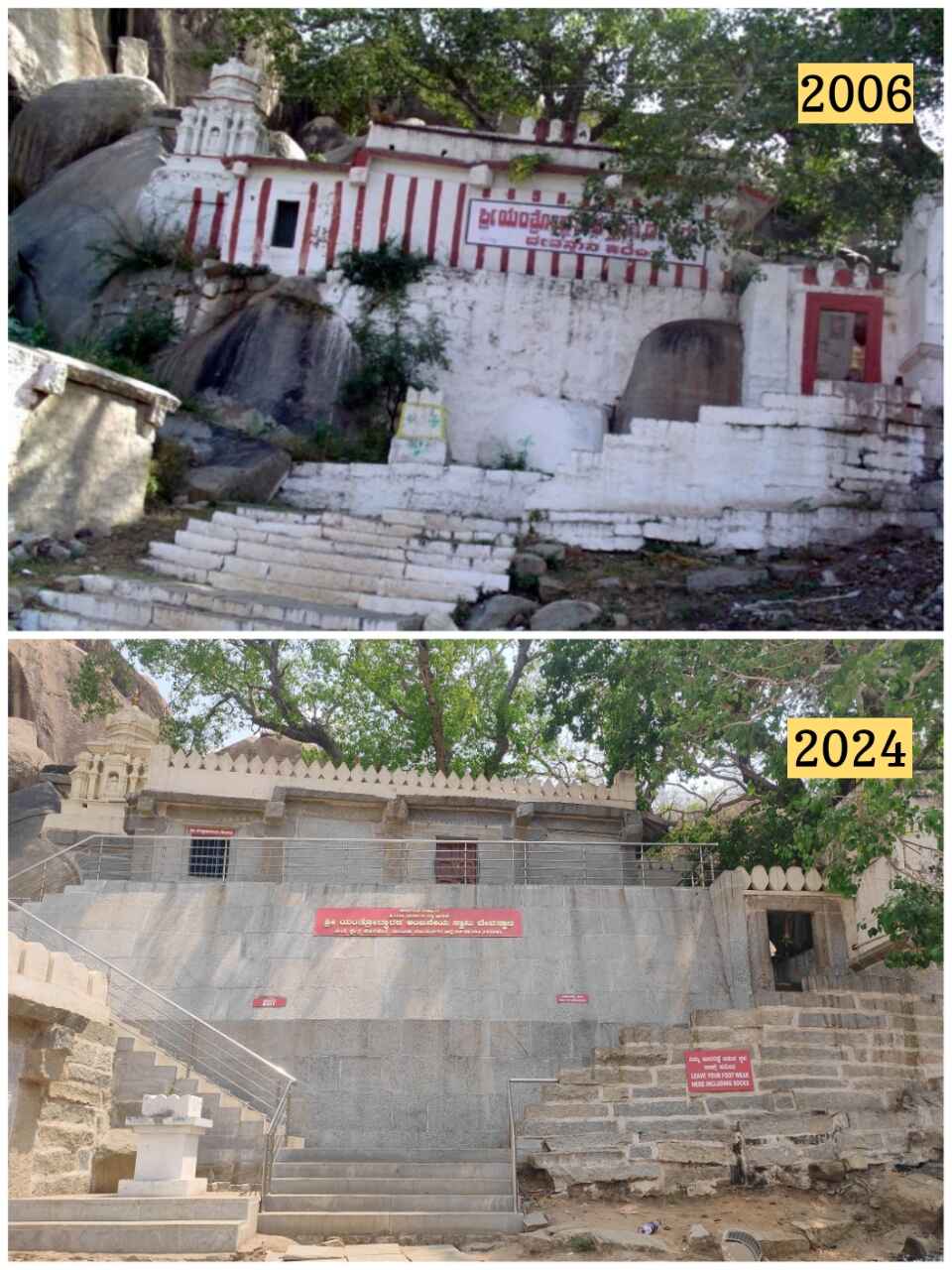
Unique Feature of Hanuman
The inner sanctum of the Yantrodharaka Hanuman temple contains an image of Lord Hanuman enclosed within a hexagonal amulet, depicted in a meditative state. Unlike traditional depictions where Hanuman stands tall and mighty, the idol here presents him in a meditative state. Seated serenely in the Padmasana posture (lotus position), he is shown within a Srichakra, a geometrical Yantra with powerful symbolism in Hinduism.
Adding layers of meaning to the idol are the twelve smaller monkey figures carved around the Yantra. These are believed to represent the twelve days of prayers Sri Vyasaraja performed before the temple’s construction. The inclusion of these figures not only showcases the dedication behind the temple’s creation but also highlights the perseverance and faith that went into its realization. Seed syllables (mantras) are also carved around the amulet, further enriching the symbolism of the idol.
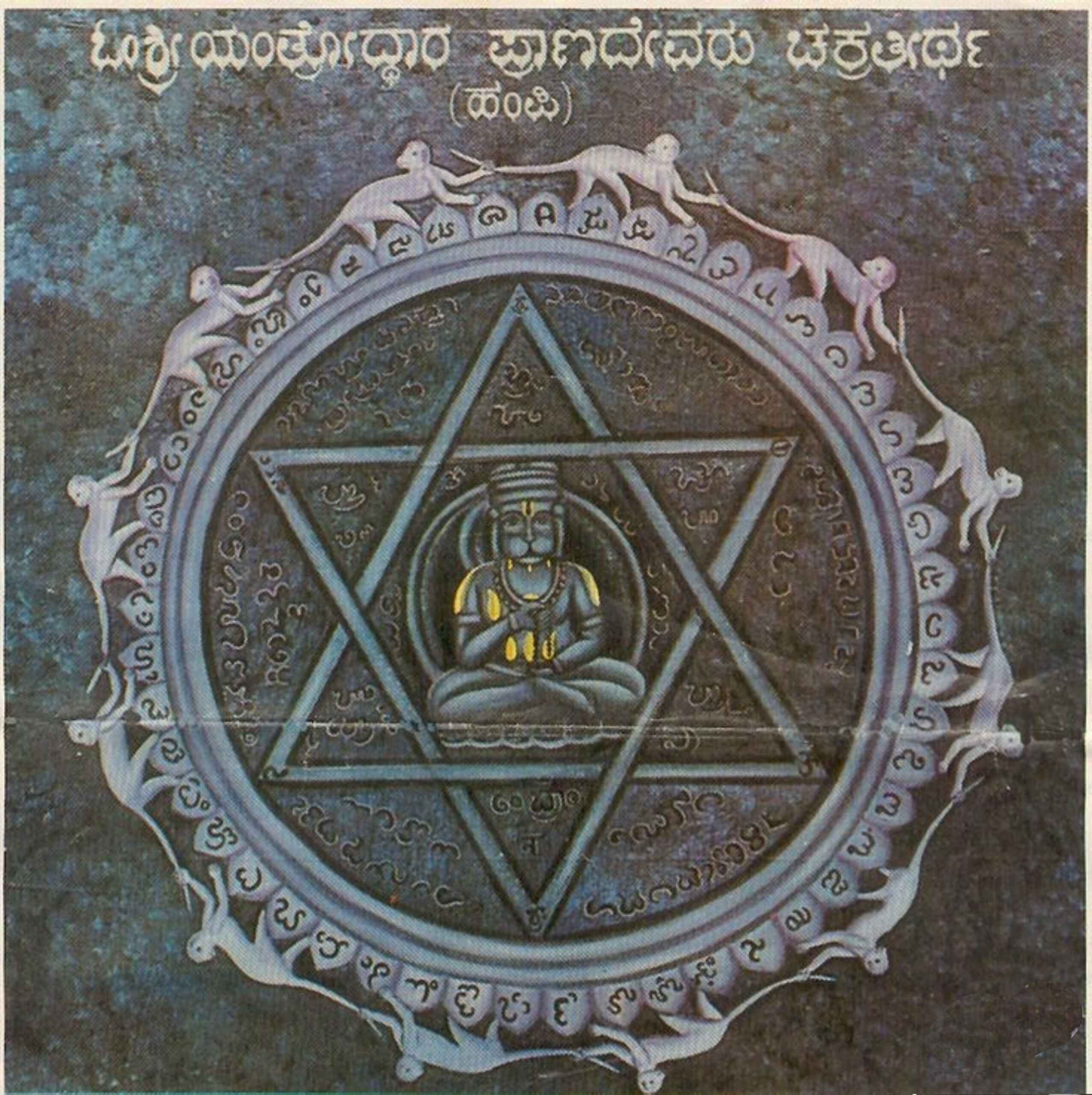
Exploring Beyond the Temple
While the Yantrodharaka Hanuman Temple itself is a captivating sight, venturing beyond its walls offers additional experiences. Just behind the Kodandarama Temple, you’ll find the entrance to the Yantrodharaka Hanuman Temple complex. A short, winding flight of steps leads you to the temple courtyard. Here, you might encounter friendly monkeys swinging through the trees, adding to the site’s charm and reminding visitors of Hanuman’s connection to the monkey kingdom.
The courtyard also features a large Sacred Fig tree with several snake stones installed around its base. These carved stones, often depicting serpent themes, hold significance in snake worship practices. Taking a moment to appreciate these details allows for a deeper understanding of the cultural and religious tapestry interwoven into the temple’s surroundings.
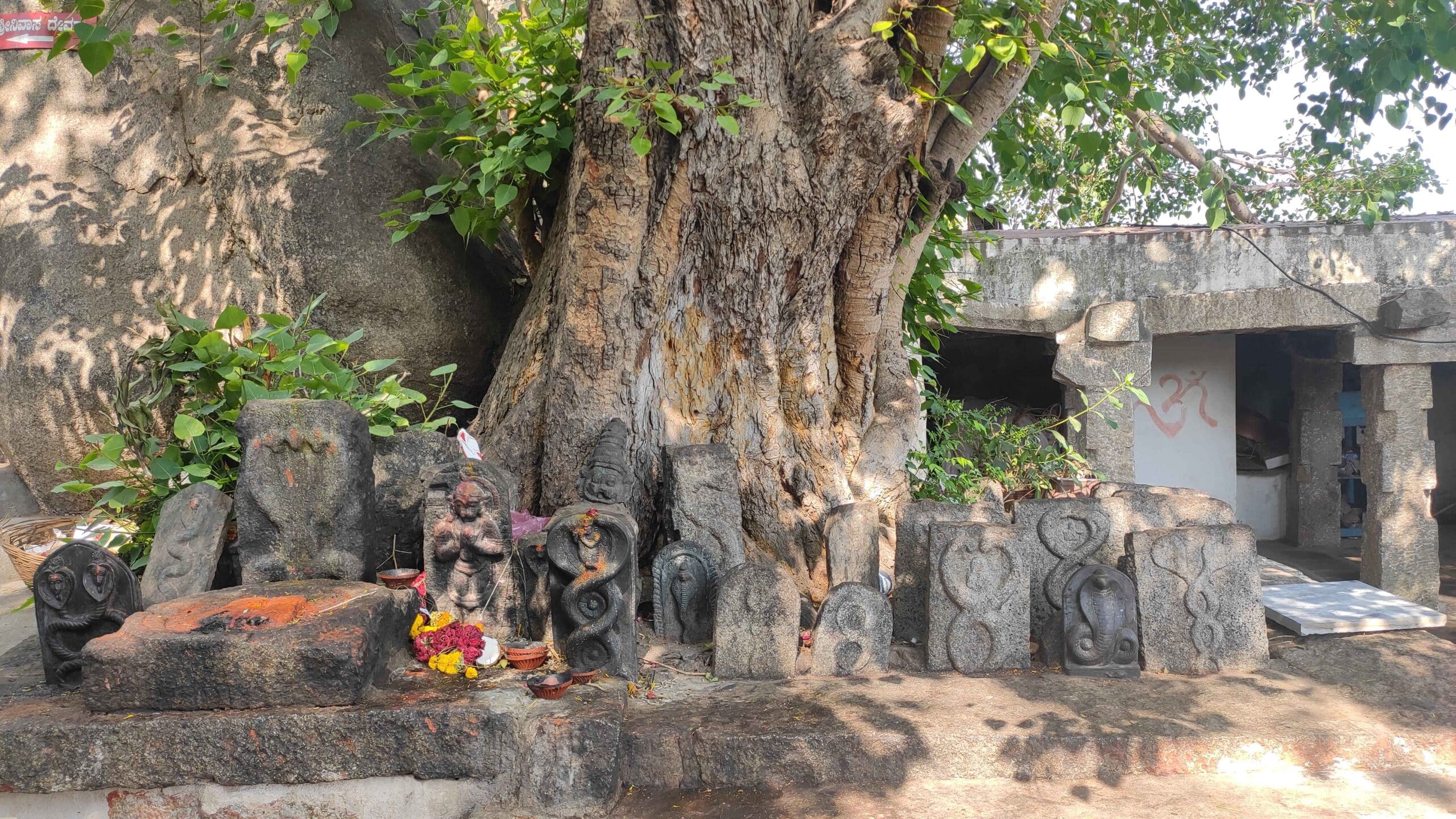
This temple is known for its simplicity rather than elaborate architectural styles. Its construction follows a simple design with minimal ornamentation. The temple typically consists of a sanctum (garbhagriha) where the main deity, Lord Hanuman, is enshrined, along with a mantapa (hall) for devotees to gather and worship. The simplicity of the temple’s architecture allows visitors to focus more on the spiritual significance of the deity rather than on intricate details. Despite its modest appearance, the temple holds great significance for devotees due to its association with the divine and the legends surrounding it.
Significance for Hanuman Devotees
It is believed that the mythical Kishkinda, the monkey kingdom depicted in the Ramayana, was located in the area where Hampi now stands. This association makes Hampi a sacred place for Hanuman devotees, who flock to the area seeking blessings and divine intervention.
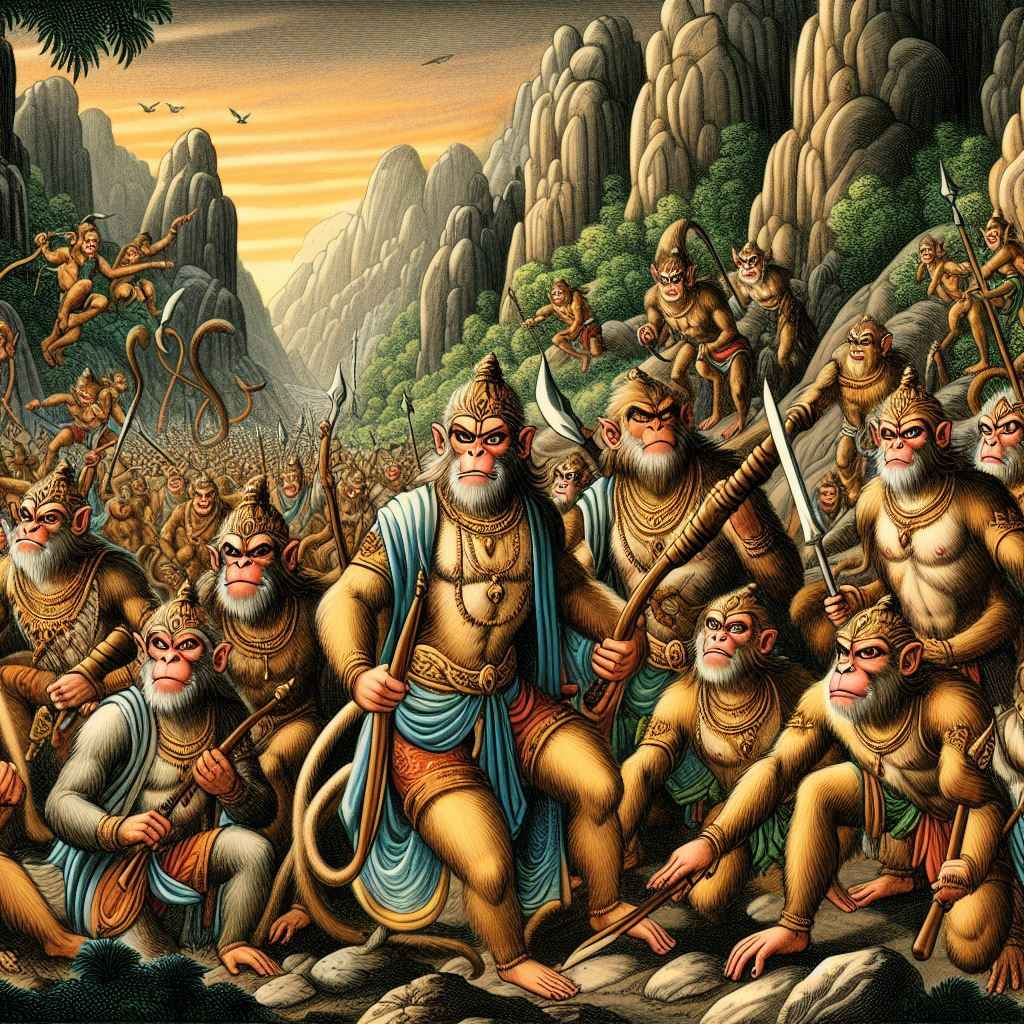
Throughout Hampi, visitors will encounter numerous motifs and carvings dedicated to Hanuman, reflecting the deep reverence for the monkey god. These artistic depictions, some vibrantly painted, serve as reminders of Hanuman’s heroic deeds and his unwavering devotion to Lord Rama. Pilgrims often visit these sites to pay homage to Hanuman and seek his protection and guidance in their lives.
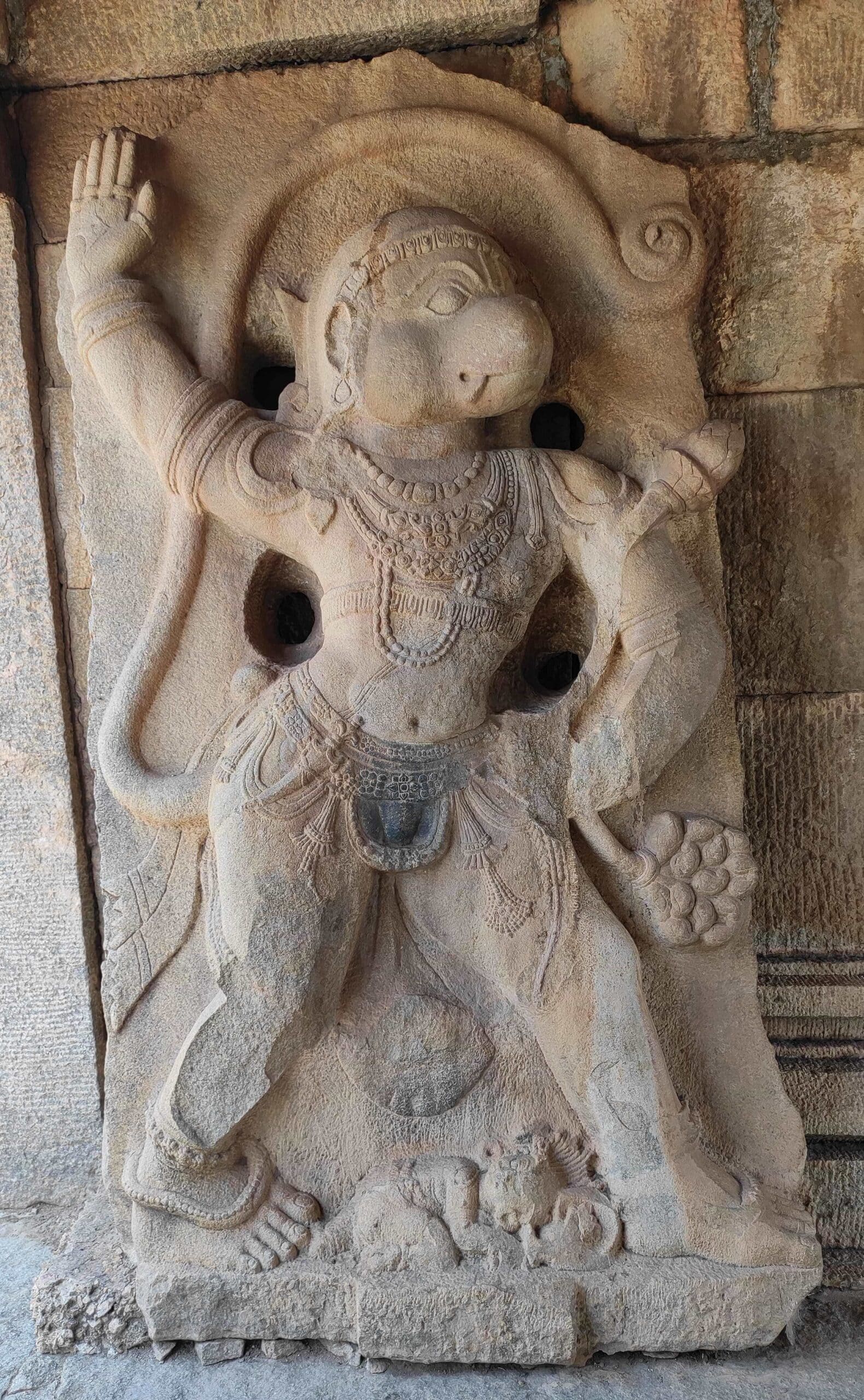
A Rare Glimpse of Pattabhirama
Within another garbhagriha lies a rare idol of Lord Rama with Sita seated on his lap, accompanied by Lakshmana standing beside them. This unique representation, known as Pattabhirama (meaning “Rama adorned with a crown” or “Rama seated on a throne”), adds to the temple’s significance for devotees of Lord Rama and his consort, Sita.
The presence of Lakshmana further enhances the sacredness of the shrine, symbolizing the divine bond between the brothers. Hanuman sits below, offering prayers to Rama, further enhancing the sacredness of the shrine. Visitors are captivated by this divine trio, drawn to the temple to seek blessings and spiritual solace in the presence of the revered deities.
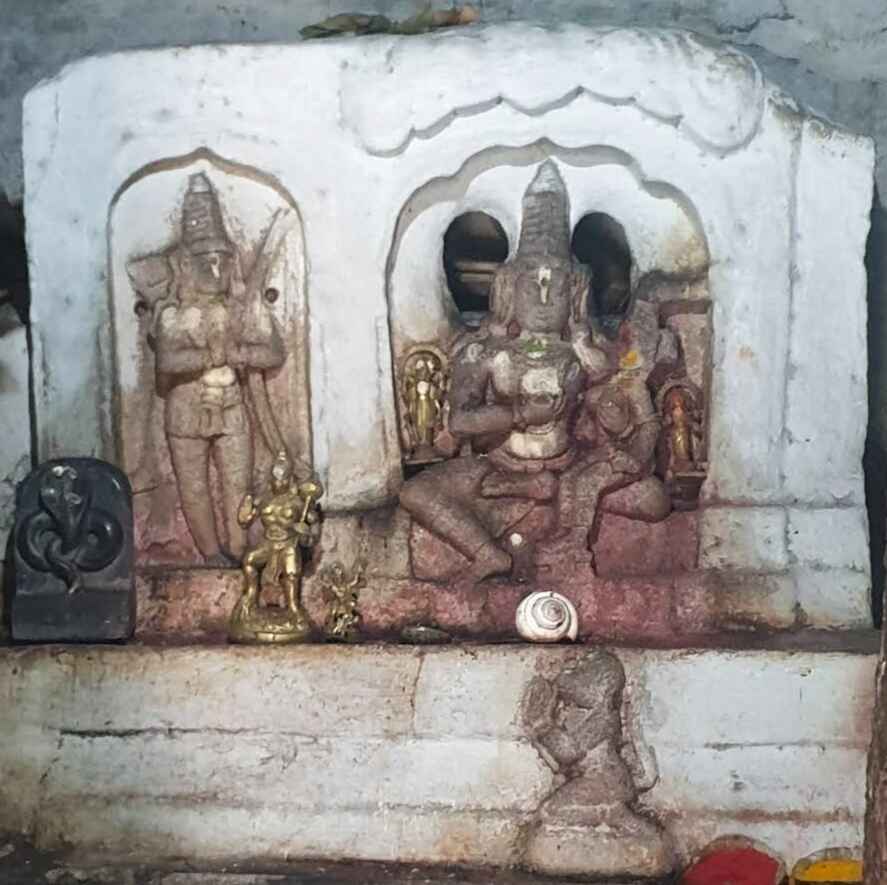
Hidden Chamber of Lord Venkateswara
Also, if you climb up to the top of the Yantrodharaka Hanuman Temple and proceed further, you will find a small chamber where Lord Venkateswara is standing. This hidden chamber adds to the spiritual significance of the temple, providing devotees with an opportunity to seek blessings from Lord Venkateswara along with Hanuman.
It offers a serene space for reflection and prayer, away from the hustle and bustle of the main temple area. Visitors are often captivated by the peaceful ambiance and the divine presence felt within the chamber, making it a cherished spot for spiritual seekers.
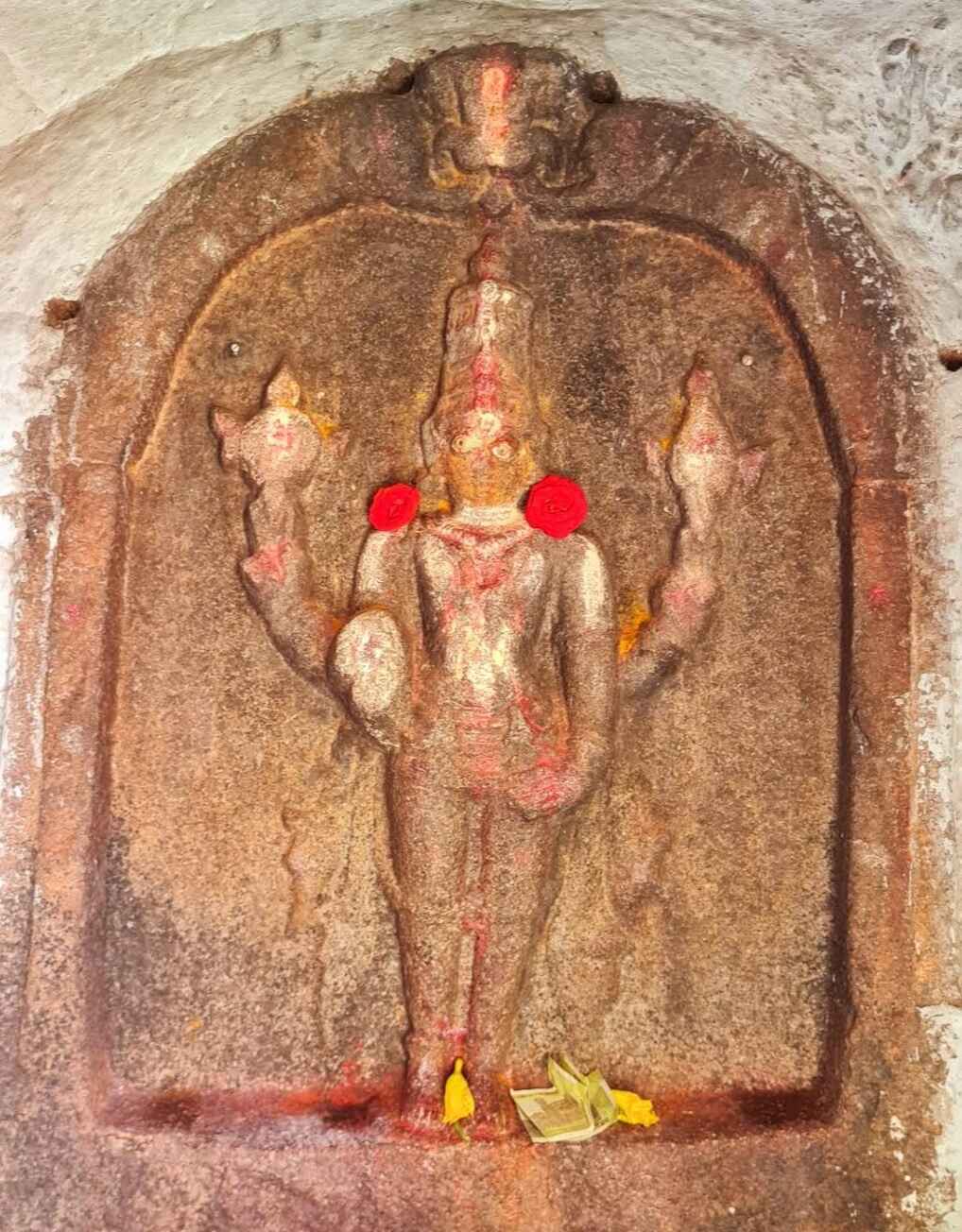
Must-see attractions at Yantrodharaka Hanuman Temple
Embark on a spiritual journey through the must-see attractions at Yantrodharaka Hanuman Temple in Hampi, where ancient legends and architectural wonders converge to offer a truly divine experience.
Pattabhirama Idol:
Witness the rare idol of Lord Rama with Sita seated on his lap, known as Pattabhirama. This unique depiction adds to the spiritual ambiance of the temple.
Hanuman’s Meditative Image:
Inside the inner sanctum, marvel at the image of Lord Hanuman in a meditative state, enclosed within a hexagonal amulet. This depiction is a deviation from the traditional standing posture of Hanuman seen elsewhere in Hampi.
Twelve Monkeys Carvings:
Take a closer look at the twelve monkeys carved around the amulet, representing the twelve days Sri Vyasaraja prayed to Lord Hanuman. Each monkey holds the tail of the one in front, symbolizing devotion and dedication.
Hidden Chamber of Lord Venkateswara:
At the top of the Yantrodharaka Hanuman Temple, you’ll discover a small chamber where Lord Venkateswara stands. This adds spiritual significance, allowing devotees to seek blessings from Lord Venkateswara.
Sacred Fig Tree and Snake Stones:
Explore the courtyard of the temple, where you’ll find a sacred fig tree surrounded by snake stones. These carved stones, depicting serpent themes, are used for snake worship and add to the mystical charm of the temple.
Monkey Sightings:
As you explore the temple complex, you might encounter friendly monkeys swinging through the trees, adding to the site’s charm and reminding visitors of Hanuman’s connection to the monkey kingdom.
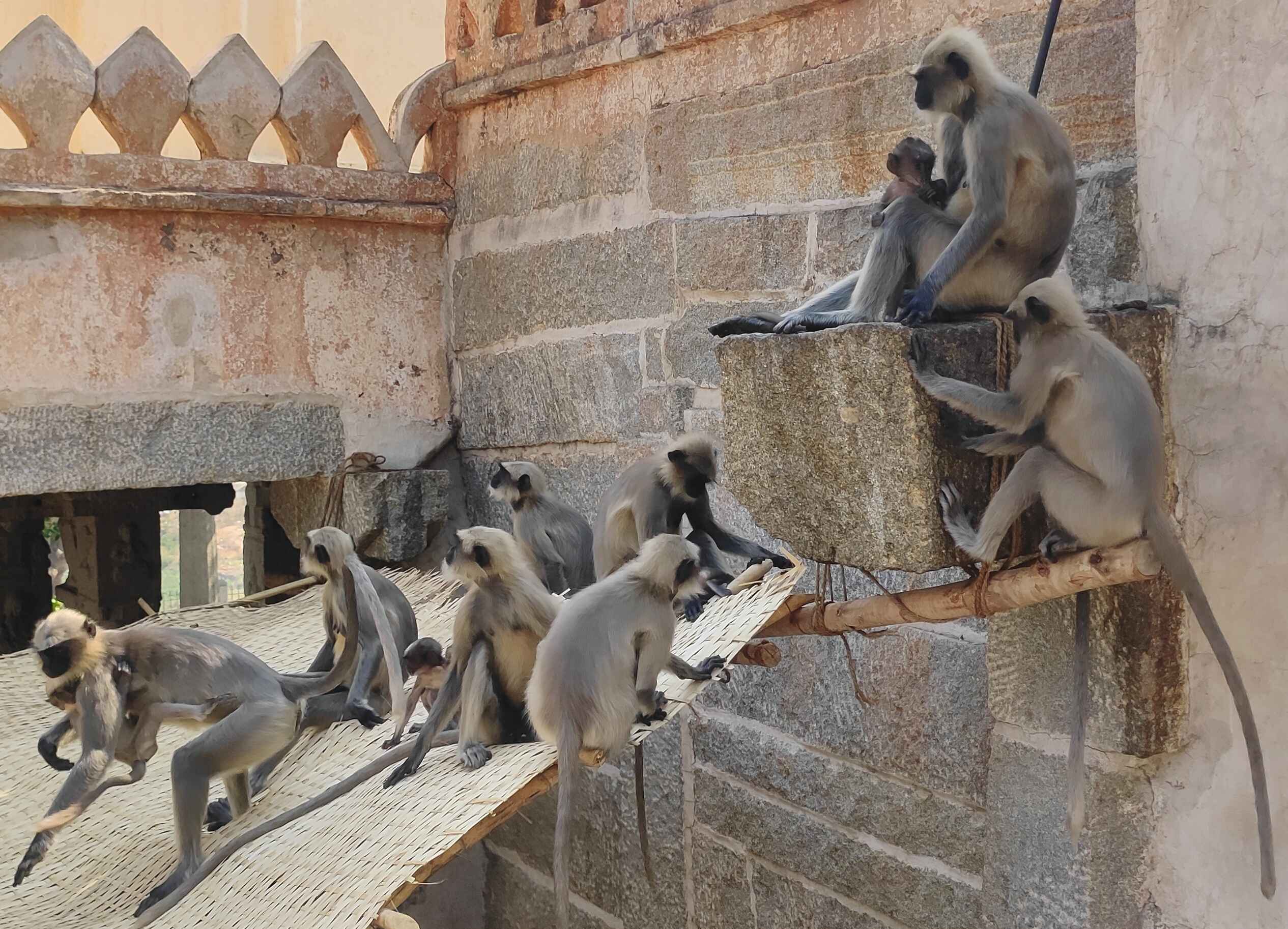
Panoramic Views:
Climb the small hillock where the temple is located to enjoy panoramic views of the surrounding landscape, including the Tungabhadra River and the Hampi ruins.
Tranquil Ambiance:
The temple exudes a sense of tranquility, with its simple architecture and calming atmosphere. The absence of elaborate ornamentation creates a space conducive to meditation and reflection.
Tips for Visitors at Yantrodharaka Hanuman Temple
Here are some helpful tips for visitors planning to explore the Yantrodharaka Hanuman Temple in Hampi. Whether you’re a first-time visitor or returning to this sacred site, these suggestions will ensure a smooth and respectful experience during your visit.
Dress modestly:
Since the temple is a religious site, it’s respectful to dress modestly. Avoid wearing sleeveless shirts, shorts, or skirts above the knee.
Remove footwear:
It is customary to remove footwear before entering the temple premises. Be prepared to leave your shoes outside the temple.
Respect the sanctity:
Maintain silence and show respect for the religious customs observed by devotees. Refrain from loud conversations or disruptive behavior.
Day of the Week:
Tuesday and Saturday are considered an auspicious day to worship Hanuman across India, and the temple tends to be busier on these days. However, you can visit and offer prayers on any day of the week.
Photography:
While photography may be allowed in certain areas, respect any restrictions on photography, especially near the main deity.
Follow temple timings:
Be mindful of the temple’s opening and closing timings to plan your visit accordingly.
Offerings:
Devotees often offer prayers, sing hymns (bhajans), and perform aarti (ritual offering of light) to Hanuman. Offering puja items like coconut, flowers, and sweets is also common.
Follow instructions:
Pay attention to any instructions given by temple staff or volunteers. They are there to ensure the smooth functioning of the temple and the safety of visitors.
Stay hydrated:
Carry water with you, especially if you plan to climb the hill to reach the temple. The weather in Hampi can be hot, so staying hydrated is important.
Be mindful of monkeys:
As the temple is located on a hill, there may be monkeys in the area. Be cautious with your belongings and avoid feeding or provoking them.
Dispose of waste responsibly:
Help maintain the cleanliness and sanctity of the temple premises by disposing of waste responsibly. Use designated bins for trash and avoid littering in and around the temple. Respect the environment and contribute to the overall cleanliness of the area.
Plan your visit during off-peak hours:
To enjoy a more serene and less crowded experience, consider visiting the temple during off-peak hours. Typically, early mornings or weekdays tend to be less crowded compared to weekends or religious festivals. This allows for a more immersive and peaceful visit.
Stay informed about festivals and special events:
Keep yourself updated about any festivals or special events taking place at the Yantrodharaka Hanuman Temple or in Hampi. Participating in these events can provide a unique and enriching experience, allowing you to witness the temple in its full glory and immerse yourself in the local culture.
Respect local customs and traditions:
Hampi is a culturally significant destination, and it is important to respect the local customs and traditions. Be mindful of local practices, such as refraining from touching or climbing on ancient structures, and seek permission before entering restricted areas.
Engage with the local community:
Hampi has a vibrant local community that can offer valuable insights and information about the temple and its surroundings. Engage in respectful conversations with locals, interact with them, and learn about the history, folklore, and traditions associated with the Yantrodharaka Hanuman Temple.
Enjoy the surroundings:
Take time to soak in the spiritual ambiance and enjoy the scenic views of Hampi from the temple premises.
Gallery:-
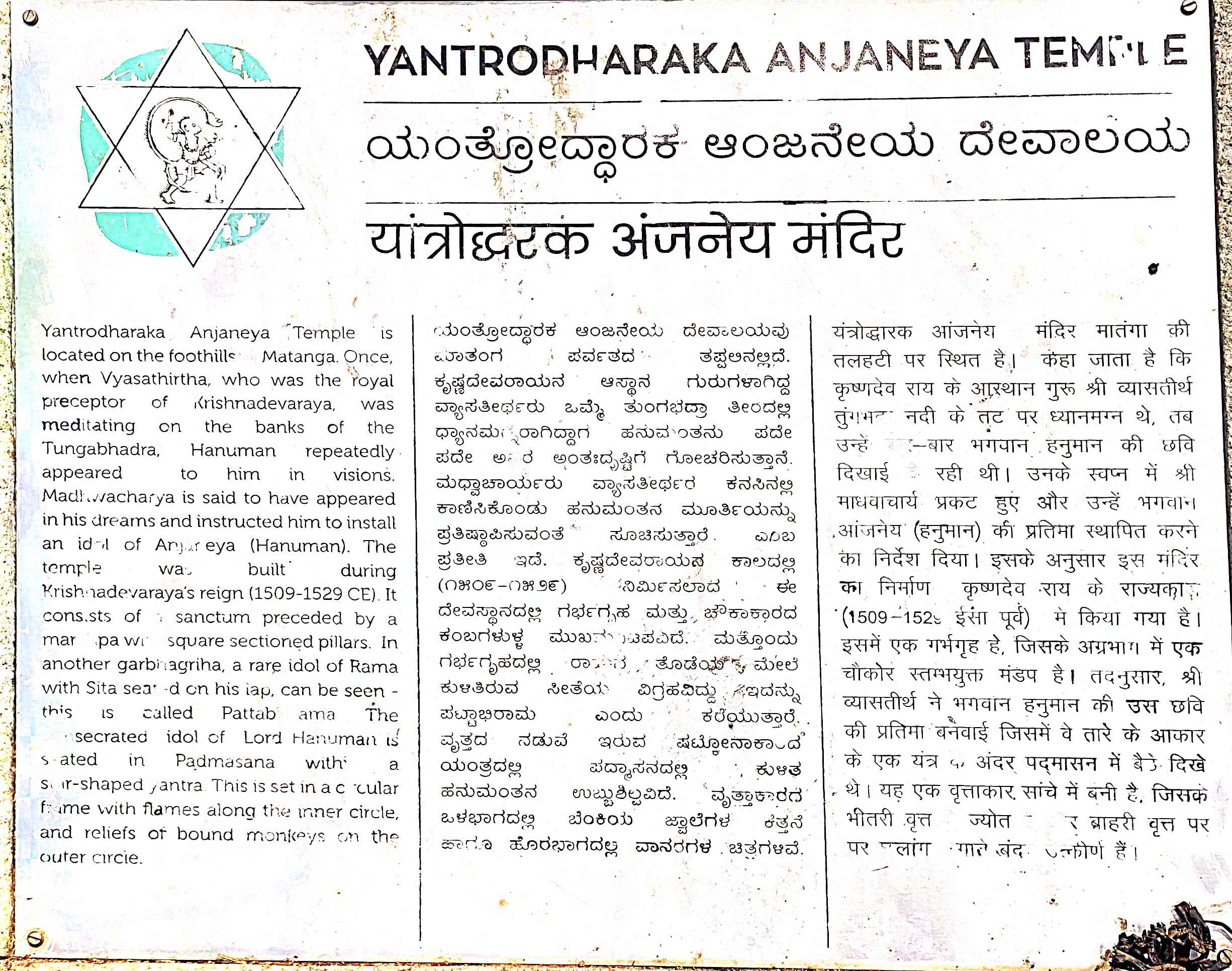
References:-
References from the Following Sources;
- ^[1] – The information about Yantrodharaka Hanuman Temple was sourced from the ASI Information plaque located at the Temple.